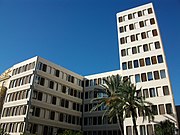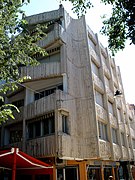Miguel Fisac
Miguel Fisac | |
|---|---|
Miguel Fisac (1913–2006) was a Spanish architect, urban planner, and painter.[1][2] He was a member of Opus Dei.[3]
Biography
Miguel Fisac Serna was born 29 September 1913 in Daimiel in Spain.[4][1] His father was Joaquín Fisac, his mother Amparo Serna.[5] He had six brothers and sisters, among them Dolores 'Lola' Fisac (1909-2005), who became one of the first female Opus Dei members.[6] He moved to Madrid aged 17 to study architecture. He was member of Catholic organization Opus Dei from 1935 till 1955, when he left.[3][1] He fled to France during the Civil War along with Opus Dei founder Josemaría Escrivá and a group of other members. He returned after the war, and graduated from ETSAM in 1942.[3] He married Ana María Badell in 1957.[7] He died 12 May 2006 in Madrid.[4]
Gallery
Laboratorios Jorba, Madrid (demolished)
Works
- Centro de Estudios Hidrográficos, Madrid (1963)[8]
- Laboratorios Jorba, Madrid, known as La Pagoda (1967, demolished 1999)[1][2]
References
- ^ a b c d Copertone, Carlos; Eguiluz, Patxi. "Miguel Fisac". Retrieved 26 August 2019.
- ^ a b Meades, Jonathan (26 August 2019). "From bombs to Benidorm: how fascism disfigured the face of Spain". Retrieved 26 August 2019.
- ^ a b c "Architects of Madrid: Miguel Fisac". Retrieved 26 August 2019.
- ^ a b "Miguel Fisac Serna (1913 - 2006)". Retrieved 26 August 2019.
- ^ "Cronología". Retrieved 26 August 2019.
- ^ Yolanda Cagigas Ocejo, Fisac Serna, María Dolores. Biblioteca Virtual Josemaría Escrivá de Balaguer y Opus Dei (PDF)
- ^ Fundación Fisac, Biografía: Una decada germinal.
- ^ "Edificio del Centro de Estudios hidrográficos". Retrieved 26 August 2019.
External links
- Fundación Fisac
 Media related to Miguel Fisac at Wikimedia Commons
Media related to Miguel Fisac at Wikimedia Commons




